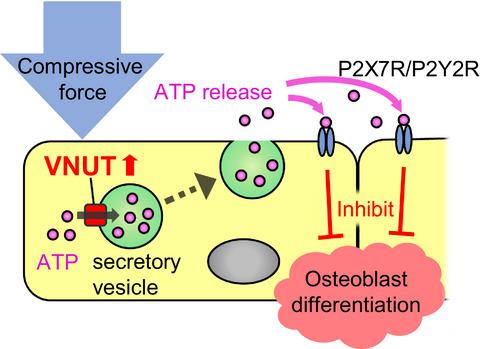当前位置:
X-MOL 学术
›
FEBS Open Bio
›
论文详情
Our official English website, www.x-mol.net, welcomes your
feedback! (Note: you will need to create a separate account there.)
VNUT/SLC17A9, a vesicular nucleotide transporter, regulates osteoblast differentiation.
FEBS Open Bio ( IF 2.8 ) Pub Date : 2020-07-12 , DOI: 10.1002/2211-5463.12918 Asako Inoue 1 , Kayoko Nakao-Kuroishi 1 , Kaori Kometani-Gunjigake 1 , Masahiro Mizuhara 1 , Tomohiko Shirakawa 1 , Misa Ito-Sago 1 , Kazuma Yasuda 1 , Mitsushiro Nakatomi 2 , Takuma Matsubara 3 , Yukiyo Tada-Shigeyama 4 , Kazumasa Morikawa 5 , Shoichiro Kokabu 3 , Tatsuo Kawamoto 1
FEBS Open Bio ( IF 2.8 ) Pub Date : 2020-07-12 , DOI: 10.1002/2211-5463.12918 Asako Inoue 1 , Kayoko Nakao-Kuroishi 1 , Kaori Kometani-Gunjigake 1 , Masahiro Mizuhara 1 , Tomohiko Shirakawa 1 , Misa Ito-Sago 1 , Kazuma Yasuda 1 , Mitsushiro Nakatomi 2 , Takuma Matsubara 3 , Yukiyo Tada-Shigeyama 4 , Kazumasa Morikawa 5 , Shoichiro Kokabu 3 , Tatsuo Kawamoto 1
Affiliation

|
Osteoblasts release adenosine triphosphate (ATP) out of the cell following mechanical stress. Although it is well established that extracellular ATP affects bone metabolism via P2 receptors [such as purinergic receptor P2X7 (P2X7R) and purinergic receptor P2Y2 (P2Y2R)], the mechanism of ATP release from osteoblasts remains unknown. Recently, a vesicular nucleotide transporter [VNUT, solute carrier family 17 member 9 (SLC17A9)] that preserves ATP in vesicles has been identified. The purpose of this study was to elucidate the role of VNUT in osteoblast bone metabolism. mRNA and protein expression of VNUT were confirmed in mouse bone and in osteoblasts by quantitative real‐time PCR (qPCR) and immunohistochemistry. Next, when compressive force was applied to MC3T3‐E1 cells by centrifugation, the expression of Slc17a9, P2x7r, and P2y2r was increased concomitant with an increase in extracellular ATP levels. Furthermore, compressive force decreased the osteoblast differentiation capacity of MC3T3‐E1 cells. shRNA knockdown of Slc17a9 in MC3T3‐E1 cells reduced levels of extracellular ATP and also led to increased osteoblast differentiation after the application of compressive force as assessed by qPCR analysis of osteoblast markers such as Runx2, Osterix, and alkaline phosphatase (ALP) as well as ALP activity. Consistent with these observations, knockdown of P2x7r or P2y2r by siRNA partially rescued the downregulation of osteoblast differentiation markers, caused by mechanical loading. In conclusion, our results demonstrate that VNUT is expressed in osteoblasts and that VNUT inhibits osteoblast differentiation in response to compressive force by mechanisms related to ATP release and P2X7R and/or P2Y2R activity.
中文翻译:

VNUT/SLC17A9 是一种囊泡核苷酸转运蛋白,可调节成骨细胞分化。
在机械应力后,成骨细胞将三磷酸腺苷 (ATP) 释放出细胞。尽管细胞外 ATP 通过 P2 受体 [例如嘌呤能受体 P2X7 (P2X7R) 和嘌呤能受体 P2Y2 (P2Y2R)] 影响骨代谢已是公认的,但成骨细胞释放 ATP 的机制仍不清楚。最近,已鉴定出一种在囊泡中保存 ATP 的囊泡核苷酸转运蛋白 [VNUT,溶质载体家族 17 成员 9 (SLC17A9)]。本研究的目的是阐明 VNUT 在成骨细胞骨代谢中的作用。VNUT 的 mRNA 和蛋白质表达在小鼠骨骼和成骨细胞中通过定量实时 PCR (qPCR) 和免疫组织化学得到证实。接下来,当通过离心对 MC3T3-E1 细胞施加压力时,Slc17a9的表达、P2x7r和P2y2r随细胞外 ATP 水平的增加而增加。此外,压缩力降低了 MC3T3-E1 细胞的成骨细胞分化能力。的shRNA的敲低Slc17a9在MC3T3-E1细胞减少外ATP的水平,并也导致增加的成骨细胞分化的压缩力的申请之后通过成骨细胞标志物如Runx2的,Osterix的,和碱性磷酸酶(ALP)的qPCR分析所评估以及ALP 活动。与这些观察结果一致,P2x7r或P2y2r 的敲低通过 siRNA 部分挽救了由机械负荷引起的成骨细胞分化标志物的下调。总之,我们的结果表明 VNUT 在成骨细胞中表达,并且 VNUT 通过与 ATP 释放和 P2X7R 和/或 P2Y2R 活性相关的机制抑制成骨细胞分化以响应压缩力。
更新日期:2020-07-12
中文翻译:

VNUT/SLC17A9 是一种囊泡核苷酸转运蛋白,可调节成骨细胞分化。
在机械应力后,成骨细胞将三磷酸腺苷 (ATP) 释放出细胞。尽管细胞外 ATP 通过 P2 受体 [例如嘌呤能受体 P2X7 (P2X7R) 和嘌呤能受体 P2Y2 (P2Y2R)] 影响骨代谢已是公认的,但成骨细胞释放 ATP 的机制仍不清楚。最近,已鉴定出一种在囊泡中保存 ATP 的囊泡核苷酸转运蛋白 [VNUT,溶质载体家族 17 成员 9 (SLC17A9)]。本研究的目的是阐明 VNUT 在成骨细胞骨代谢中的作用。VNUT 的 mRNA 和蛋白质表达在小鼠骨骼和成骨细胞中通过定量实时 PCR (qPCR) 和免疫组织化学得到证实。接下来,当通过离心对 MC3T3-E1 细胞施加压力时,Slc17a9的表达、P2x7r和P2y2r随细胞外 ATP 水平的增加而增加。此外,压缩力降低了 MC3T3-E1 细胞的成骨细胞分化能力。的shRNA的敲低Slc17a9在MC3T3-E1细胞减少外ATP的水平,并也导致增加的成骨细胞分化的压缩力的申请之后通过成骨细胞标志物如Runx2的,Osterix的,和碱性磷酸酶(ALP)的qPCR分析所评估以及ALP 活动。与这些观察结果一致,P2x7r或P2y2r 的敲低通过 siRNA 部分挽救了由机械负荷引起的成骨细胞分化标志物的下调。总之,我们的结果表明 VNUT 在成骨细胞中表达,并且 VNUT 通过与 ATP 释放和 P2X7R 和/或 P2Y2R 活性相关的机制抑制成骨细胞分化以响应压缩力。









































 京公网安备 11010802027423号
京公网安备 11010802027423号